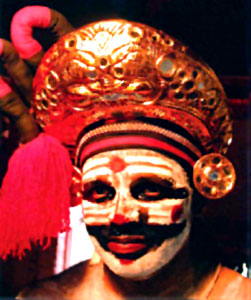 Vidushaka the jester, originating in Sanskrit theatre, occupies a central position like the sutradhar. He creates laughter through instant witticisms and jocular speech, rotund and ugly appearance, fanciful costume, and eccentric gestures. He is a humorous companion and confidential friend of the hero, and excites mirth by allowing himself to be made the butt of ridicule by almost everybody in a play. Often, he is engaged quarrelling with the maidservant in the inner palace apartments reserved for women. However, he should not be equated with a buffoon or fool. In spite of his clownish nature, he is intelligent and therefore the hero`s confidant and counselor. He is near and dear ones especially in matters of love. He frequently sounds a note of caution when he notices something wrong in the hero`s behaviour. He has the liberty of commenting satirically on religious institutions, political authorities, or social customs. Even in a mythological or historical play, he makes connections to contemporary realities with ease and felicity. Thus he has a strikingly strong and ever-fresh concern about popular problems.
Vidushaka the jester, originating in Sanskrit theatre, occupies a central position like the sutradhar. He creates laughter through instant witticisms and jocular speech, rotund and ugly appearance, fanciful costume, and eccentric gestures. He is a humorous companion and confidential friend of the hero, and excites mirth by allowing himself to be made the butt of ridicule by almost everybody in a play. Often, he is engaged quarrelling with the maidservant in the inner palace apartments reserved for women. However, he should not be equated with a buffoon or fool. In spite of his clownish nature, he is intelligent and therefore the hero`s confidant and counselor. He is near and dear ones especially in matters of love. He frequently sounds a note of caution when he notices something wrong in the hero`s behaviour. He has the liberty of commenting satirically on religious institutions, political authorities, or social customs. Even in a mythological or historical play, he makes connections to contemporary realities with ease and felicity. Thus he has a strikingly strong and ever-fresh concern about popular problems.
The vidushaka held a major place in such forms of Sanskrit theatre as the comic prakarana, farcical prahasana, and solo bhana. He had some common names like Vasantaka and Madhavya, and spoke vulgar Prakrit. He developed in later traditional forms into a number of denominations. In the two broad lines of descent, temple theatre and secular theatre, for obvious reasons he hardly appeared in the former though in Kutiyattam. He often takes centre stage with long solo flights of raillery, but assumed many varieties in the latter. In Nautanki he became the munshi, in Raslila the manasukha, in Naqal the naqqal, in Bandi Pethir the band, in Bhavai the ranglo, in Tamasha the songadya, in Yakshagana the hanumnayaka or hasyagam, in Kuchipudi the konnagi and many more.
This article is a stub. You can enrich by adding more information to it. Send your Write Up to content@indianetzone.com




















